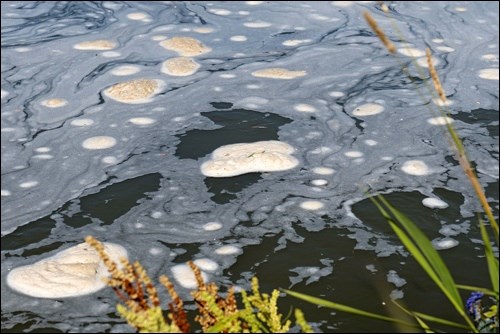North Battleford, Prince Albert – A 16-inch pipeline on the Husky gathering system for northwest Saskatchewan leaked Wednesday, July 20, spilling approximately 200 to 250 cubic metres (1,258 to 1,572 barrels) of heavy oil and diluent.
The leak was initially reported as having occurred during the morning of Thursday, July 21, but an initial incident report filed by Husky with the Saskatchewan Ministry of Economy on July 26 stated, “On July 20, 2016 at approximately 2000h, a pipeline release was discovered on the south shore of the North Saskatchewan River, upstream of the south isolation valve site on 12-17-051-24-W3M.”
The line is part of the Husky gathering system, which collects heavy oil from facilities north of the North Saskatchewan River. The incident occurred near, but not at, the point where the pipeline crossed the river, south of Paradise Hill. The spill occurred on the south shore of the river, in the river valley, approximately 300 metres from water. While the nature of the pipeline failure has yet to be determined, the oil flowed over land and entered the river near a Husky facility built along its shore.
As noted in the report, the first evidence of a leak was detected at approximately 8 p.m. on July 20, but the pipeline was shut down with manual valves at 10:30 a.m. the following day. Crews were mobilized early on July 21, and since then, hundreds of contractors have been working on the problem.
Immediate recovery actions by Husky involved building a berm on land to capture as much oil as possible before it reached the water. On Monday, July 25, Husky officials reported that approximately 70 cubic metres of oil and soil had been collected at the source. The following day they reported 145 cubic metres of an oily water mix was collected.
A containment boom deployed at the Payton river ferry site July 21 proved ineffectual, as the plume of heavy oil and diluent continued past it and downstream. By July 24, a total of five containment booms had been put in place at Highway 21, Paynton Ferry, two at North Battleford and one at Maymont. Despite this, the oil plume reached Prince Albert, approximately 370 kilometres downstream, by the morning of July 25.
The City of North Battleford has two water treatment plants – one that draws water directly from the North Saskatchewan River, and another that draws from groundwater wells immediately adjacent to the river, but onshore. The surface water plant was shut down July 21, and by July 22, the city ordered water conservation measures be put into place, including shutting down car washes and laundromats, as well as lawn watering. By July 25, the city was looking at temporary measures where they would draw water from the Battle River on the south side of Battleford.
Prince Albert, on the other hand, is primarily reliant on water from the North Saskatchewan River for its water supplies. As a result, Friday, July 22, it was advising residents to store up water in bottles and to fill bathtubs. Eventually, all car washes, laundromats and water parks were shut down, and essentially all outdoor water use was banned, with a $1,400 fine for enforcement. July 25, it declared a local state of emergency and shut down all intake from the North Saskatchewan River. Prince Albert had intended to draw water from treated water reservoirs and start drawing water from stormwater retention ponds as an interim measure. They expected to have enough water to be able to handle a week’s shutdown of their water intake. The plume reached Prince Albert early July 25.
Over the weekend the city began construction of an approximately 30 kilometre surface pipeline, using irrigation equipment, to draw water from the South Saskatchewan River. The line ran to the east along Highway 302 to a point downstream of Muskoday First Nation. The 10-inch line was characterized as a “hose,” by Saskatchewan Water Agency officials, who noted these measures would not be useful past freeze up.
Other communities downstream also draw their water from the river. Laird uses it intermittently to fill their reservoir, and during the spill response, it shut down such withdrawals. Melfort, and approximately 12 other communities that draw water from the Codette Reservoir near Nipawin, shut down its pipeline July 26. It reverted to its old surface reservoir, not used since 1993.
The provincial government has been holding daily press teleconferences, initially with representation from the Ministries of Environment and Economy, but eventually including Health, Environment and Climate Change Canada and Husky.
Al Pate, Husky’s vice-president of exploration and production services, said July 25, “We realize this has been a very challenging time for everybody, with the spill impacting people, the environment and local businesses.
“We’re deeply sorry this has happened. We accept full responsibility for the event and the cleanup, and we will make things right.
“We’re working closely with the communities, First Nations, governments and regulators to respond to the incident.”
July 25 Husky began cleanup of the first 20 kilometres of shoreline, starting at the spill site.
Referring to the fact that interim above-ground pipelines would freeze in cold weather, Sam Ferris, executive director of environmental and municipal management services at the Saskatchewan Water Security Agency, said on July 25, “It’s not going to be a short-term event.
“We want to be certain that source water is safe and secure before it is reused for treatment for drinking water purposes … We need further time just to assess the existence of any oil or globules of oil that may be suspended in the water column.”
Pate noted Husky would be covering the costs regarding this spill, and said a toll-free phone line was set up at 844-461-7991.
By July 26, four birds, three fish and one frog had been reported as impacted by the oil.
With the pipeline shut down, Husky has been using trucking to replace its capacity.



